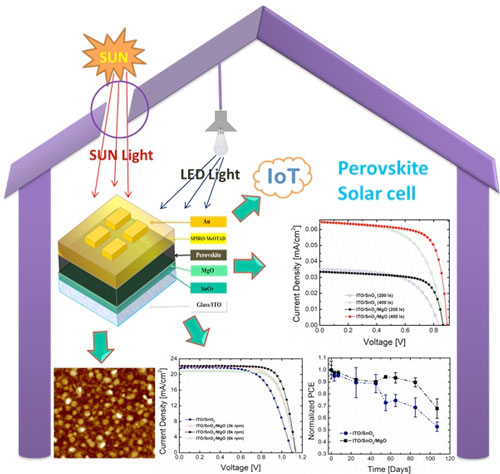| Posted: Jun 11, 2018 |
Perovskite solar cell technology for exceptional light harvesting under indoor illumination
(Nanowerk News) Perovskite solar cells have been attracting great attention from the scientific and industrial communities in the past few years because they are able to combine high power conversion efficiencies under standard test conditions (i.e. those of the sun) with simple manufacturing processes. The films that make up the cells are in fact cast from solution (i.e. printed via inks) or evaporated over large areas.
|
|
Franco Cacialli, Professor of Physics in the London Centre for Nanotechnology and the Department of Physics and Astronomy at UCL, in collaboration with researchers at the Centre for Hybrid and Organic Solar Energy (CHOSE), Department of Electronic Engineering University of Rome – Tor Vergata, have developed perovskite solar cells with maximum power density under white LED illumination of 20.2 µW/cm2 at 200 1x and 41.6 µW/cm2 at 400 1x (corresponding to a power conversion of 27%).
|
|
The authors of the work believe these to be the highest power output densities ever reported under illumination conditions typically found in homes and offices. The exceptional performance under indoor lighting was achieved by incorporating new solution-processed SnO2/MgO composite electron transport layers between the perovskite semiconductor film and the bottom transparent electrode. The thin MgO overlayer enhances efficiency by roughly 20%, reducing charge recombination which is especially important at the low light levels typically found indoors.
|
|
Results have recently been published in Nano Energy ("Highly efficient perovskite solar cells for light harvesting under indoor illumination via solution processed SnO2/MgO composite electron transport layers").
|
 |
| Figure schematizing the demonstration of perovskite solar cell technology with outstanding power outputs under indoor lighting for powering electronics in smart buildings, the internet of things, and wireless sensors. (Image: LCN)
|
|
All layers of the cells, except for the two electrodes, were solution processed at low temperatures, making the technology easy to integrate with other printed electronic components on the same substrate, and compatible with low cost manufacturing. Ambient indoor conditions represent a milder environment compared to stringent outdoor conditions suggesting an initial commercial outlet which is much less taxing on device lifetimes for this technology.
|
|
Thus, the researchers suggest that the unparalleled performance demonstrated, furnishes these devices with another new powerful competitive attribute that can pave the way for perovskite solar cells to contribute strongly to energy harvesting and the powering of the indoor electronics of the future (e.g. the fast-rising markets of autonomous indoor wireless sensor networks and the internet of things).
|
|
The results have been published in Nano Energy: “Highly efficient perovskite solar cells for light harvesting under indoor illumination via solution processed SnO2/MgO composite electron transport layers”, Janardan Dagar, Sergio Castro-Hermosa, Giulia Lucarelli. Franco Cacialli, Thomas M. Brown.
|
About the Centre for Hybrid and Organic Solar Energy (CHOSE)
|
|
The Centre for Hybrid and Organic Solar Energy (CHOSE) was founded in 2006 from the will of the Lazio Region and the University of Rome Tor Vergata to create a center of excellence in the field of next-generation photovoltaics. CHOSE is distributed across several laboratories including the new main laboratory within the Campus of Tor Vergata University in Rome. The latter consists of a more than 400 square meter laboratory that houses equipment for the fabrication and characterization of organic, hybrid, dye sensitized and perovskite photovoltaic cells, modules and panels. The other laboratories, totalling roughly 300 square meters in extension, are located within different departments of Tor Vergata. More than 25-30 researchers work at CHOSE including graduate students, postdocs and staff. CHOSE has also many collaborations at the regional, national and international levels.
|
|
The main objectives of CHOSE consist in the development of fabrication processes for organic and hybrid organic / inorganic solar devices, the definition of a process for the industrialization of these innovative photovoltaic technologies, the technological transfer of these and the development of photovoltaic applications in collaboration with companies at both the domestic and international level.
|

